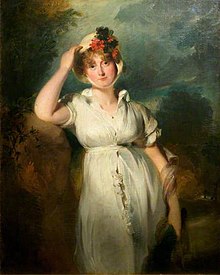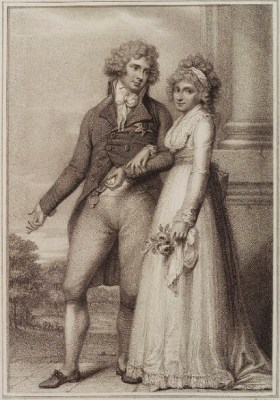Princess Caroline of Brunswick was involved in one of the 18th century's most notorious scandals. It is why her name is now on one of Melbourne's best known suburbs.

Brunswick was one of Melbourne’s first suburbs.
Surveyor Robert Hoddle, famous for laying out Melbourne’s inner city ‘grid’ of streets, assessed the area in 1839. Less than two years after the city was founded, Hoddle found the land suitable for settlement; the boundaries of the new suburb would be; Moreland Road to the north, Park Street to the south (both still in existence), Moonee Ponds Creek to the west, and Merri Creek to the east.
Connecting Moreland Road and Park Street would be a broad thoroughfare, running north-south, originally called Pentridge Road (later renamed ‘Sydney Road’, the name it has today).
The land on either side of Pentridge Road was divided into eleven equal sections, which went on sale in 1840.
These were mostly bought by land speculators; investors who sat on the property, and waited for it to appreciate. Melbourne was still small at this time, the new suburb five miles from town was not yet heavily in demand.
But a few people settled on their properties straight away. One of these was Thomas Wilkinson.

Wilkinson was born in Sunderland County, in England, in 1799.
In 1833 he emigrated to Van Dieman’s Land; like many British settlers, hoping to make his fortune in a new country. He worked a variety of jobs in Launceston, followed by a stint on Flinders Island.
In 1840, Wilkinson moved to Melbourne, and found work as a law clerk. Within a year he had saved a sufficient sum to allow him to buy one of the new parcels of land in Hoddle's new, still unnamed, suburb. He built a small house on the corner of Albert Street and Sydney Road, and so became one of the area's first residents.
Wilkinson called his property 'Brunswick.' It was named after Caroline of Brunswick, a German Princess who had become something of a 19th century celebrity.

Caroline was born in Brunswick, a region in northern Germany, near Hannover, in 1768.
Her father, the Duke of Brunswick, was a minor nobleman in the German Royal family. Caroline’s mother, Princess Augusta, was English and better connected; she was the elder sister of George III, King of England.
George’s son, also named George, was heir to the British throne, and his selection of a wife much discussed. It was joked that every German Princess was taught English, so that she would have a chance of being chosen.
Caroline's mother used her connections to push her daughter's prospects. Caroline was pretty, had a carefree air, and came from the right family. She seemed like the perfect candidate.

The marriage was duly arranged. Caroline was engaged to George in 1794, and married him the following year.
The two never met prior to their engagement. Their families arranged the wedding; Caroline’s to gain the prestige of producing the British royal consort, George’s as they had been promised a larger allowance by Parliament if he selected a European princess as his wife.
But the two were ill suited.
George was authoritarian with a bombastic personality, completely at odds with his gentle natured wife. He also complained that Caroline was uneducated, and treated her condescendingly. He drank heavily, and was rude and insulting to Caroline’s face.
After Caroline gave birth to a daughter, Charlotte, in 1796, the pair began to live apart. It is likely that both Prince and Princess took lovers, and had little to do with each other.
Caroline was so unhappy that she eventually left England altogether, in 1814, and lived in Italy for six years. She only returned in 1820, after the death of George III, for her husband’s coronation.
George was not happy to see her.

In his wife's absence, the soon to be King had returned to a bachelor lifestyle.
George spent and entertained lavishly, and had a string of mistresses, barely concealed from the public. His excessive consumption of alcohol, and general debauchery, was widely discussed.
When Caroline returned, determined to take her place at his side, George began to plan for divorce.
But there was a complication. George's excessive lifestyle had made him unpopular with his subjects. In addition, he was accused of ruling despotically, ignoring Parliament and forcing his policies through with blunt force.
Caroline, by contrast, was well liked. She was viewed as sweet natured and pious, and as having the ‘common touch’ when she met and spoke with everyday people.

George knew divorce proceedings, instigated by him, would be viewed unfavourably. And so he set out to damage his wife’s reputation.
Caroline was publicly accused of adultery, then a serious criminal offence.
The House of Lords, charged with the preliminary investigation, called witnesses from her time in Italy. English society was scandalised as it was revealed that Caroline had spent considerable time with one of her servants, Bartolomo Pergami. One witness claimed that he had seen them in bed together, and that it was widely known they were lovers.
But as salacious as these details were, they were never widely believed. Caroline remained enormously popular with the masses; 800 petitions, with more than a million signatures, were lodged in support of her during the trial.
George’s subterfuge had been easily seen through.

While the House of Lords found Caroline guilty of adultery, criminal proceedings could not continue until this was ratified by the House of Commons.
This was never even attempted. George knew his wife’s popularity would have ensured her acquittal in the house.
Furious that his will was not carried out, George excluded Caroline from his coronation ceremony at Westminster Abbey, where he was crowned George IV. When she tried to attend, her way was blocked several times by soldiers.
Shortly afterward, Caroline became seriously ill and deteriorated steadily over the next few weeks.

She died on 7 August 1821, aged 53, and was buried in her native Brunswick. Her death was widely mourned, people also speculated that agents of the King had her poisoned.
The scandal surrounding George’s behaviour turned Caroline into a celebrity, and a symbol.
She was venerated, and even adopted as a figurehead of political movements, agitating for Parliamentary reform. The events were well known through the English speaking world.

A young Thomas Wilkinson lived through this period and knew Caroline’s story well. He named his new property in Melbourne after her, a small tribute to the fate of the late Princess.
Wilkinson spent a few years in Portland, on Victoria's south coast, where he was elected to the Legislative Assembly in 1851.
On his return to the city, his house doubled as the new suburb's first church and post office. He started, and for a time edited, the its first newspaper, and would eventually would serve as its first mayor.
He was the dominant personality in the area, and was synonymous with it.
So when the local government finally got around to naming the new suburb, they had only one real candidate. It would be known as ‘Brunswick’, taken from the name of the house of its best known resident.
It has retained the name to this day.

Although, in 1914, there was an effort to have Brunswick re-named.
As the First World War erupted in Europe, and anti-German fever ran high across the British Commonwealth, the North Brunswick Progress Association lobbied the local council to change the name. They knew of Brunswick’s German origin, and they did not want to be associated with a label taken from the enemy.
The council's response to this complaint is not recorded.

